The history of gelatin and Jell-O from the 19th century to the present.
Published in University of Oregon’s comics magazine ArtDucko, issue 20. Complete transcript and sources here. Created in collaboration with A. Service, who also wrote a companion blog post about our gelatin party.
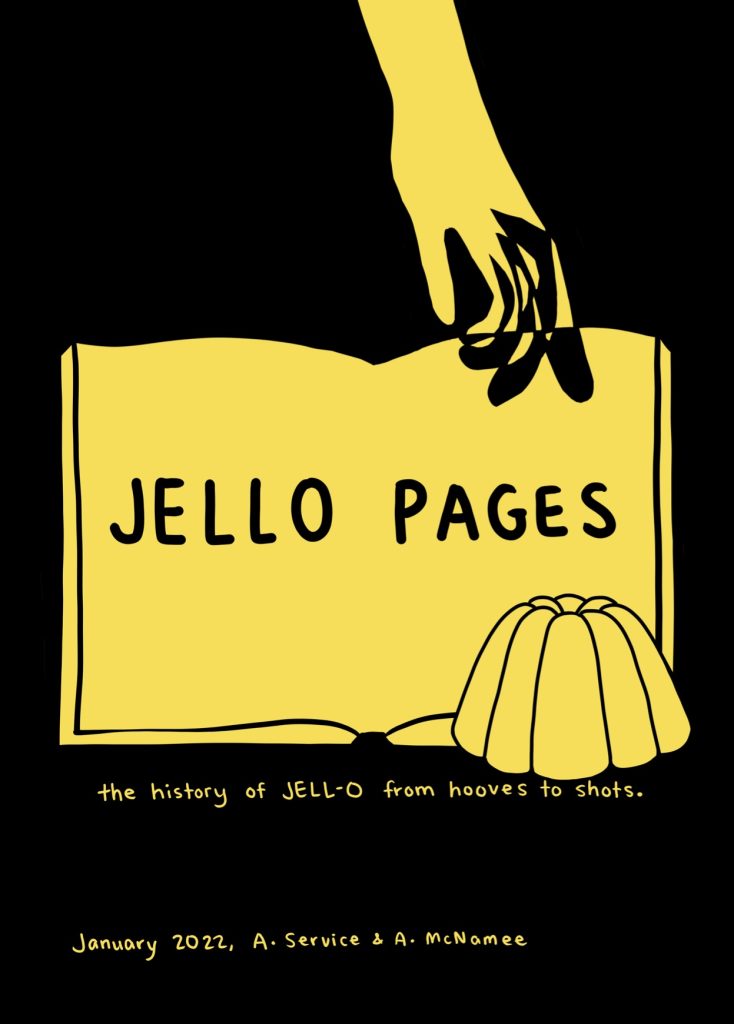
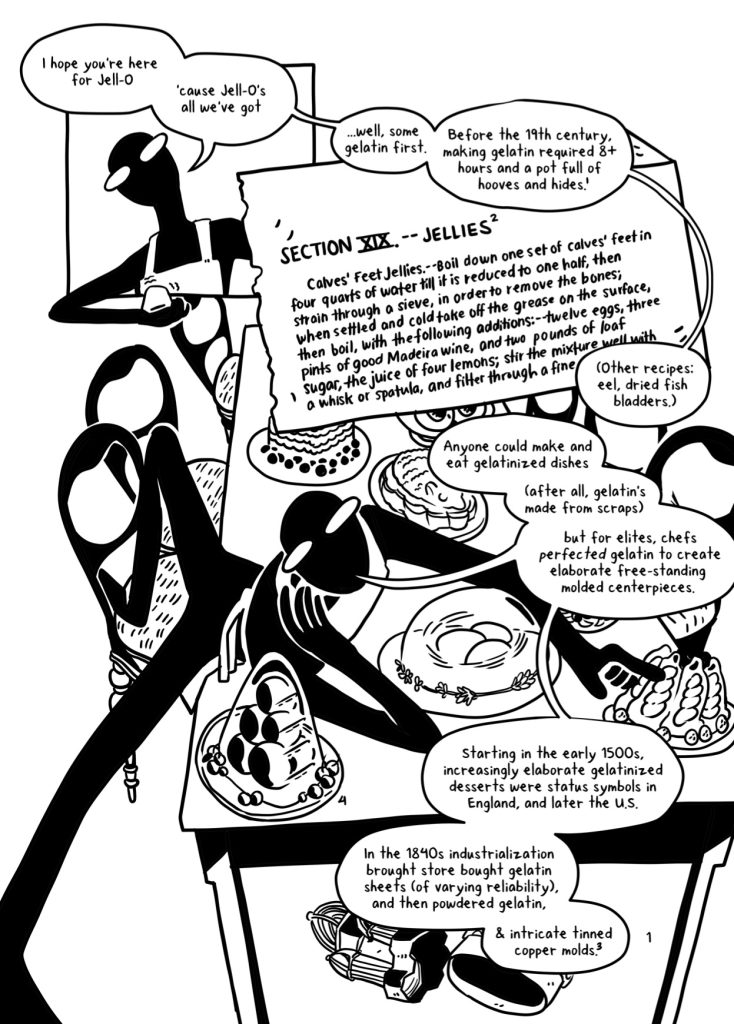

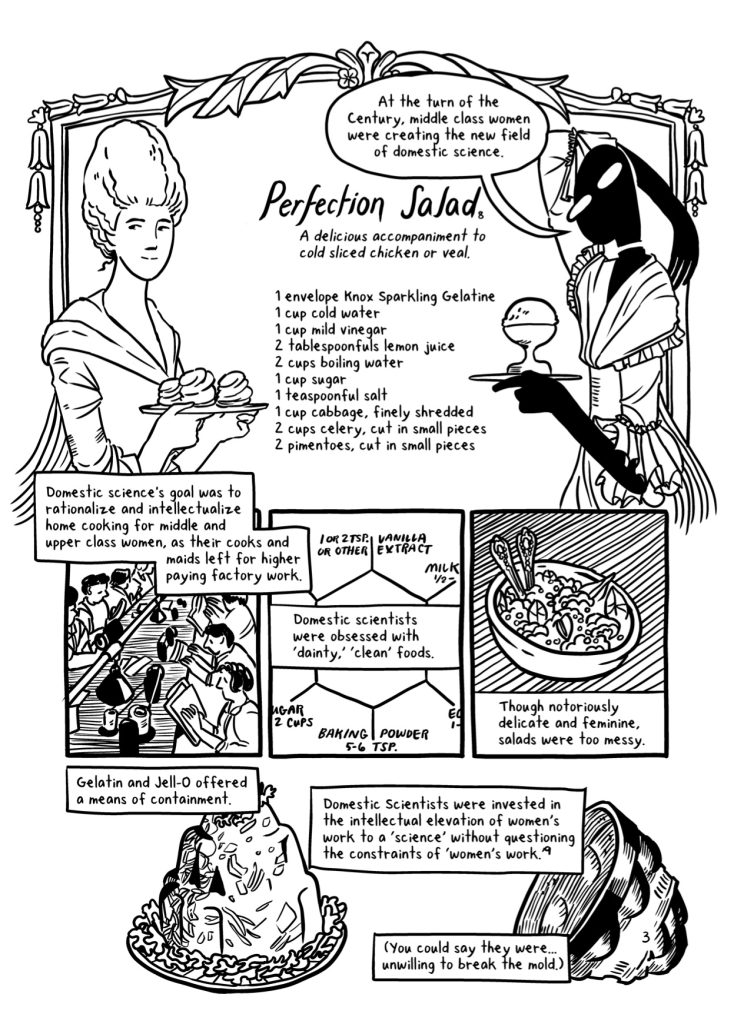
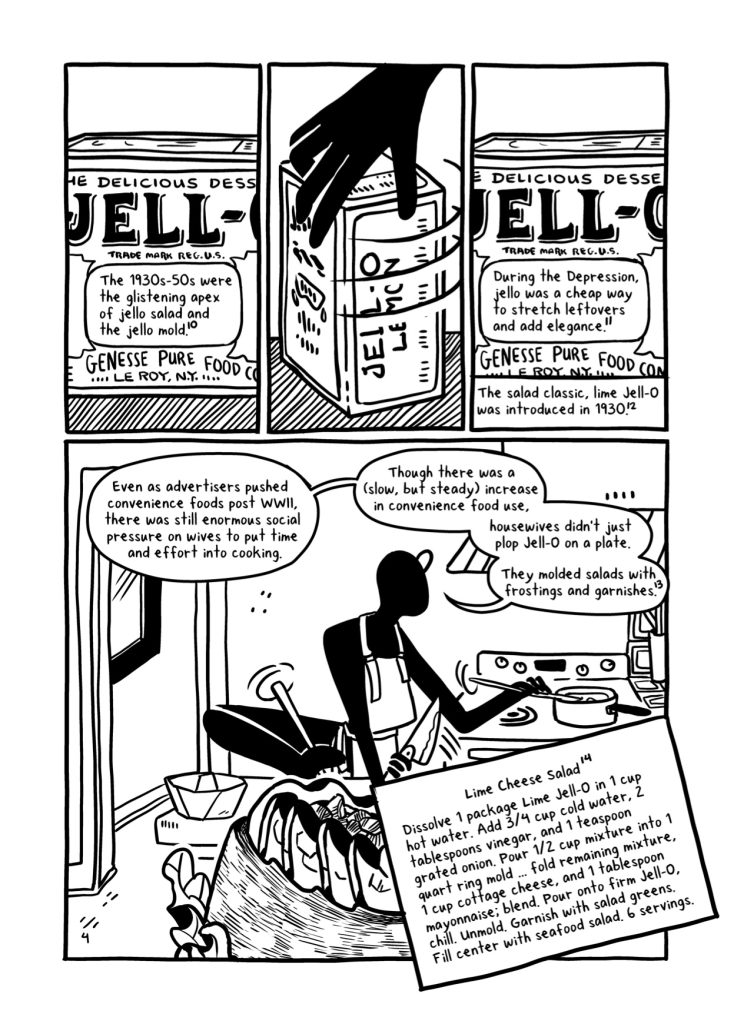
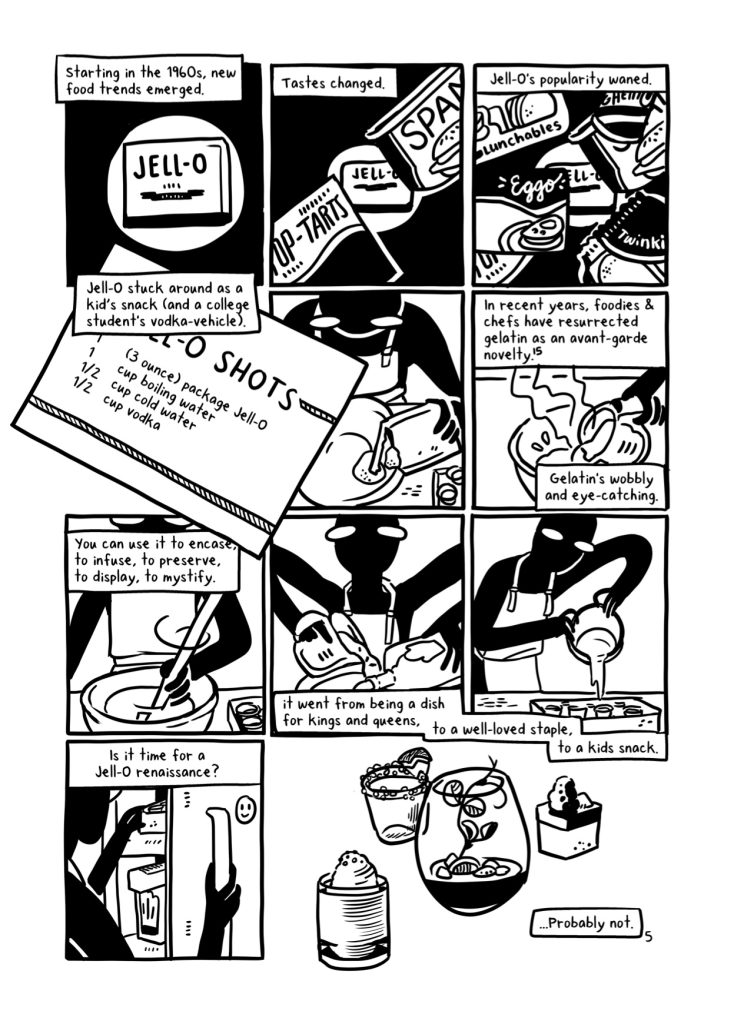

Cover Page:
TITLE: JELLO PAGES
SUBTITLE: the history of Jell-O from hooves to shots. January 2022, A. Service and A. McNamee
[ID: Cover is black with yellow lettering. The title is written across the center of an open yellow book, next to a small ridged Jell-O mold. A hand reaches down from the top of the page to rest on the pages of the book.]
Page One:
[ID: NED, a solid black humanoid demon with long, spindly limbs and large, white oval shaped eyes and no other features, wears an apron and sprawls across a large table. The table is covered in elaborate gelatin creations, including eggs in gelatin dome, tall jello molds with swirly and round fillings and a mold shaped like a hedgehog. Under the table are two intricate copper molds. Blocking part of the table is a recipe for calves foot jelly.]
NED: “I hope you’re here for Jell-O ‘cause Jell-O’s all we’ve got…well, some gelatin first. Before the 19th century, making gelatin required 8+ hours and a pot full of hooves and hides [2]. (Other recipes: eel, dried fish bladders).
Recipe: Section XIX. – Jellies [2] Calves’ Feet Jellies.– Boil down one set of calves’ feet in four quarts of water till it is reduced to one half, then strain through a sieve, in order to remove the bones; when settled and cold take off the grease on the surface, then boil, with the following additions: –twelve eggs, three pints of good Madeira wine, and two pounds of loaf sugar, the juice of four lemons; stir the mixture well with a whisk or spatula, and filter through a fine… [ID: the rest of the recipe is obscured.]
NED: “Anyone could make and eat gelatinized dishes (after all, gelatin’s made from scraps) but for elites, chefs perfected gelatin to create elaborate free-standing molded centerpieces. Starting in the early 1500s, increasingly elaborate gelatinized desserts were status symbols in England, and later the U.S. In the 1840s industrialization brought store bought gelatin sheets (of varying reliability), and then powdered gelatin and intricate tinned copper molds [3].
Page Two:
1897: Cough syrup manufacturer Pearl Wait saw potential in Knox gelatin’s flavorless powdered gelatin. As a man in the patent medicine field, his expertise led him to add 88% sugar and “fruit” flavorings.
[ID: a page with six panels. Panel one shows a dapper man with a pointy mustache in a tuxedo, he is touching his chin as if in thought, a thought bubble reads: “add 88% sugar and “fruit” flavorings. The man is standing in front of a sign for LeRoy, NY.]
His wife May named the new product Jell-O!
[ID: panel two shows a middle aged woman with an elaborate up-do in profile, saying “Jell-O!”]
But Pearl had little success selling Jell-O
[ID: panel three shows the same dapper man rushing around showing another man a pamphlet labeled Jell-O.]
So in 1899 he sold the brand for $450 to Orator Woodward, owner of Genesee Pure Food Company. [5]
[ID: panel four shows the dapper man shaking hands with an older man with slicked back hair, also in a tuxedo.]
Jell-O continued to struggle until 1902 when Orator placed ads in Ladies Home Journal, the first of Jell-O’s many iconic marketing campaigns. These ads featured beautiful drawings of Jell-O– Many also drew on racist imagery. This is explored in a digital exhibit by the University of Michigan [6]. (the Jell-O girl is Elizabeth King, actual daughter of the advertising artist assigned to Jell-O in 1904 [7])
[ID: panel five shows orator woodward with his head in his hands, sitting on a pile of Jell-O boxes. Panel six shows two recreations of historic Jell-O ads, a young girl with a bob in a frilly dress holds a tray of wine glasses filled with Jell-O.]
Page Three:
[ID the top half of the page has a decorated border, on one side of the border is a woman with a huge beehive like historical hair do in a 19th century style dress, holding a tray of cream puffs. On the other side of the border is NED in a similar frilly dress with a corset, taking the place of the other woman. Inside the border is a recipe for perfection salad.]
Perfection Salad [8]: A delicious accompaniment to cold sliced chicken or veal. 1 envelope Knox Sparkling Gelatine, 1 cup cold water, 1 cup mild vinegar, 2 tablespoonfuls lemon juice, 2 cups boiling water, 1 cup sugar, 1 teaspoonful salt, 1 cup cabbage, finely shredded, 2 cups celery, cut in small pieces, 2 pimentos, cut in small pieces. At the turn of the Century, middle class women were creating the new field of domestic science. Domestic science’s goal was to rationalize and intellectualize home cooking for middle and upper class women, as their cooks and maids left for higher paying factory work. Domestic scientists were obsessed with ‘dainty,’ ‘clean’ foods.
[ID: on the lower half of the page, one panel shows a long table full of young women wearing dresses, aprons, and gloves reading books. The next panel shows a hexagonal diagram with ingredients written next to each corner: milk ½, baking powder 5-6 tsp, sugar 2 cups, 1 or 2 tsp vanilla extract or other. A third panel shows a messy salad in a bowl with fancy silverware]
Though notoriously delicate and feminine, salads were too messy. Gelatin and Jell-O offered a means of containment. Domestic Scientists were invested in the intellectual elevation of women’s work to a ‘science’ without questioning the constraints of ‘women’s work’ [9]. (You could say they were…unwilling to break the mold)
[ID: a large 3 tiered gelatin salad on a bed of lettuce with veggies visibly encased inside, a large mold sits next to the gelatin.]
Page Four:
[ID: the top of the page is split into three vertical panels, an old fashioned Jell-O page has text boxes on it. NED’s hand rotates the box in the middle panel so the reader can see the text on the other side]
The 1930s-50s were the glistening apex of jello salad and the jello mold [10]. During the Depression, jello was a cheap way to stretch leftovers and add elegance [11]. The salad classic, lime Jell-O was introduced in 1930 [12].
[ID: the bottom half of the page is one big panel, in the foreground is a recipe for Lime Cheese Salad, and a large elaborate Jell-O mold. Behind them, NED is in a kitchen, wearing an apron. NED is stirring a pot on the stove, holding a knife and stirring something else with its foot.]
NED: “Even as advertisers pushed convenience foods post WWII, there was still enormous social pressure on wives to put time and effort into cooking. Though there was a (slow, but steady) increase in convenience food use, housewives didn’t just plop Jell-O on a plate. They molded salads with frostings and garnishes [13].
Lime Cheese Salad [14]: Dissolve 1 package Lime Jell-O in 1 cup hot water. Add 3/4 cup cold water, 2 tablespoons vinegar, and 1 teaspoon grated onion. Pour 1/2 cup mixture into 1 quart ring mold … fold remaining mixture, 1 cup cottage cheese, and 1 tablespoon mayonnaise; blend. Pour onto firm Jell-O, chill. Unmold. Garnish with salad greens. Fill center with seafood salad. 6 servings.
Page Five:
Starting in the 1960s, new food trends emerged. Tastes changed. Jell-O’s popularity waned.
[ID: three panels at the top of the page, the first is a spotlight on a Jell-O box. Then Jell-O is partially obscured by Spam and Pop-tarts, in the third panel Jell-O is almost fully obscured by Lunchables, Eggo Waffles, and Twinkies.]
Jell-O stuck around as a kid’s snack (and a college student’s vodka-vehicle)
[ID: a recipe for Jell-O shots partially covers a panel of NED boring Jell-O powder into a bowl]
JELL-O SHOTS: 1 (3 ounce) package Jell-O, 1 cup boiling water, 1/2 cup cold water, 1/2 cup vodka.
In recent years, foodies & chefs have resurrected gelatin as an avant-garde Novelty [15]. Gelatin’s wobbly and eye-catching. You can use it to encase, to infuse, to preserve, to display, to mystify. it went from being a dish for kings and queens, to a well-loved staple, to a kids snack.
[ID in a series of panels NED pours boiling water into the bowl of Jell-O powder, stirs the water in, pours the liquid into a pitcher, pours the Jell-O into a tray of shot glasses, and puts them into the fridge. Finally there is a panel that shows four avant garde desserts, a shot glass rimmed in salt with a lime wedge, a small glass with layers of gelatin and cream, a small square dessert, and a large juice glass with slayer of gelatin, garnishes and a small plant.]
Is it time for a Jell-O renaissance? …Probably not.
Citations:
Further Reading: We especially recommend Ivan Day’s blog for a fascinating look at recreation historical English gelatin. For a more modern take, check out Dr. Ken Albala’s food blog prominently featuring modern aspics. Sarah Grey’s history of Jell-O salad is excellent, and for anyone interested in gender and food history Laura Shaprio’s books are both must-reads.
[ID: NED reclines at the bottom of the page, his body is black, but when his limbs overlap they turn white, in a geometric pattern.]
- Peter Brears, Jellies & Their Moulds (Prospect Books, 2010);
- Kristin Holt, “Victorian Jelly: Desserts,” Kristin Holt (blog), April 7, 2021, http://www.kristinholt.com/archives/24150.
- Peter Brears, Jellies & Their Moulds
- Ivan Day, “Macedoine and Other Eccentric Jellies,” Food History Jottings (blog), June 30, 2013, http://foodhistorjottings.blogspot.com/2013/06/macedoine-and-other-eccentric-victorian.html;
- Carolyn Wyman, Jello: A Biography, 2001;
- Nicole Tarulevicz and JJ Jacobson. Jell-O: America’s Most Famous Dessert: At Home Everywhere | Bibliography and Further Reading · Online Exhibits. 2015, https://apps.lib.umich.edu/online-exhibits/exhibits/show/jell-o/imagining-the-other-intro.
- Genesee Pure Food Co, Jell-O: The Dainty Dessert (Leroy, N.Y.: Genesee Pure Food Co., 1905), https://catalog.hathitrust.org/Record/010747354;
- “Dainty Desserts for Dainty People / Emergence of Advertising in America: 1850-1920 / Duke Digital Repository,” Duke Digital Collections, accessed January 27, 2022, https://repository.duke.edu/dc/eaa/CK0028;
- Laura Shapiro, Perfection Salad (HarperCollins, 1986);
- Carolyn Wyman, Jello: A Biography, 2001;
- Sarah Grey, “A Social History of Jell-O Salad,” Serious Eats, accessed August 9, 2021, https://www.seriouseats.com/history-of-jell-o-salad;
- Carolyn Wyman, Jello: A Biography, 2001;
- Laura Shapiro, Something from the Oven (Penguin Books, 2004);
- Kris Manty, “How Jell-O Salads Created a Culinary Sensation,” Antique Trader, accessed December 19, 2021, https://www.antiquetrader.com/features/how-jello-salads-created-a-culinary-sensation;
- Ken Albala, “Ken Albala’s Food Rant: BTL in a Martini. Or BLTini.,” Ken Albala’s Food Rant (blog), August 7, 2019, http://kenalbala.blogspot.com/2019/08/btl-in-martini-or-bltini.html; “A Jell-O Salad Revival: Is Grandma’s Dark Horse Ready to Ride Again?,” The Canned Peaches Project (blog), October 29, 2019, https://cannedpeachesproject.com/a-jell-o-salad-revival-is-grandmas-dark-horse-ready-to-ride-again/.
Citation links and full transcript at audmcname.com
Instagram and Twitter: @audmcname